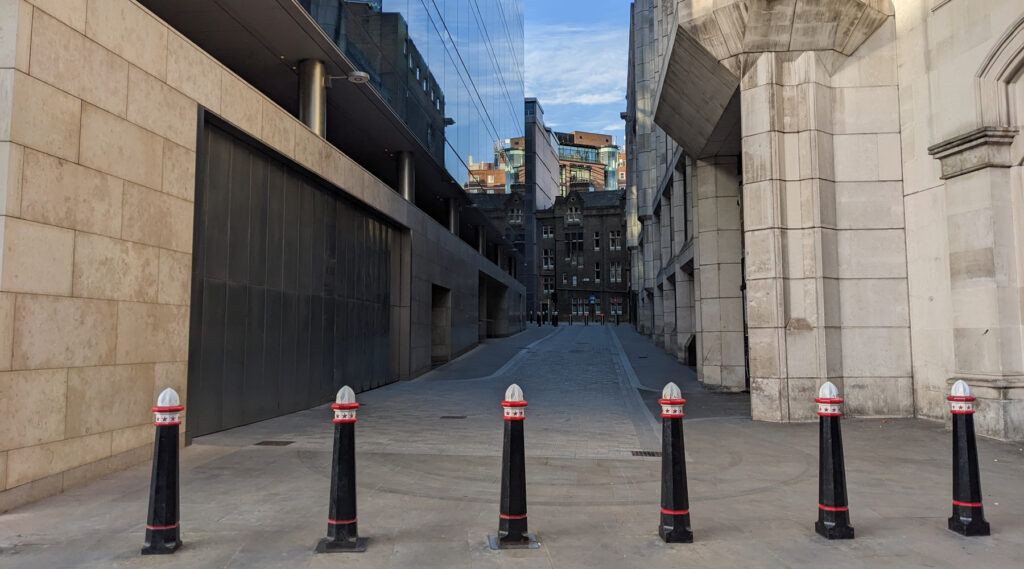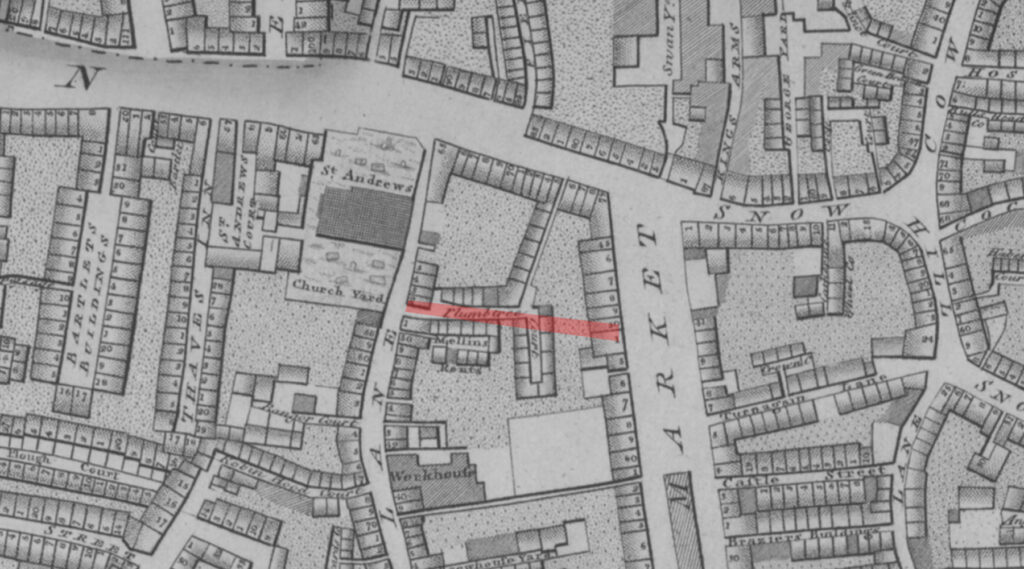This is a fairly wide modern rebuild of an old alley near Holborn that came into existence around 300 years ago.
Back in Tudor times, when there was more green and fewer buildings, this part of London was occupied by Holborn Manor. The later Agas Map of 1561 shows a large open farmland with a large house and an ornamental garden to the south side of the manor house.
By the 1600s though, it was built up and densely populated and two small courtyards in the area are named on the William Morgan map of 1682, as Windmill Inne and Cockpit Court. However, the area changed swiftly and both seemed to vanish within the next few decades. That is likely due to the rebuilding of the Fleet River as a canal and a number of wharves and warehouses being built in the area to handle cargo.
The New Canal, built by Robert Hooke was not a success though, and eventually, the Fleet River was covered over and a large market occupied the newly built Farringdon Road. It’s also around now that Plumtree Court arrives — as a long alleyway on John Roque’s 1746 map that lists it as Plumptre Court.
The earliest reference to it being spelt as Plumtree Court is August 1772, and it’s considerably easier to see on R Horwood’s map of 1799.
Putting a large market in the middle of a wide road wasn’t a clever idea, and it moved sideways to a dedicated market just to the south of Plumtree Court in the late 1820s and finally closed in 1883.
What created the wider passageway that we see today though can be largely laid at the construction of the Holborn Viaduct, which saw a lot of changes in the area. It was then that Plumtree Court gained its current layout, and it’s hardly changed since.
There used to be two offices here – the most notable was the 1960s Fleet Building, designed in a strict modernist style by Eric Bedford. It’s notable as it was London’s largest telephone exchange, but also had 600 staff at its peak, manually processing 25,000 telegraph messages daily. When the building was being earmarked for demolition just before the London Olympics, there was a campaign to save the ground floor murals created by Dorothy Annan, and they were later relocated to the Barbican estate.
The area to the south is today dominated by the single large modern office block occupied by Goldman Sachs.
The north side is a smidge more interesting in that while it’s mainly the back of a 1980s office and the City Temple church, there was an interesting occupant in the office basement. It was Food for All, a charity that provides thousands of free vegetarian meals every day to community groups and local authorities, as well as on the streets for people without accommodation.
That building is also in the middle of being demolished, so the food charity is moving out, and a hotel will soon replace the former offices, and the cycle of change continues.
The odd thing though is that as far as I can tell, there have never been any plum trees in the area.









“The odd thing though is that as far as I can tell, there have never been any plum trees in the area.”
Could it be named for Henry Plumptre, of the Nottingham Plumptre family, who was responsible for building in the Bloomsbauiry area at this time
https://www.ucl.ac.uk/bloomsbury-project/streets/plum_street.htm
I served an apprenticeship at
C&E Layton as a typesetter in the 1960’s. We had the top part of the building, the lower half being used for the production of the Evening Standard. There have been two buildings on the site in Plumtree Court since then. I believe it’s now occupied by Bloombergs.
.
The name Plumptre apparently dates back a very long way!
https://www.surnamedb.com/Surname/Plumptre
My 5x great grandfather owned 43 Shoe Lane (next to the workhouse on the earlier map) and also some houses in nearby Red Lion Court. He was a pewterer, and left the properties and business to his eldest son. These buildings were all compulsorarily purchased by the City of London when the new Fleet Market was built. His son did not accept the amount of compensation offered and took the City to court. Although he was awarded an increase, I assume it wasn’t enough to cover his costs. He died penniless in the workhouse.
I think the place was named much earlier, but may be not on maps. I have found reference to it on 13 October 1698 in St Andrews burial register.
Thank you for such an interesting story.